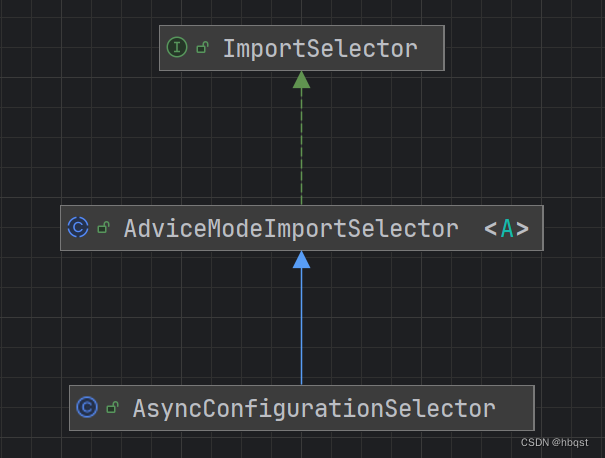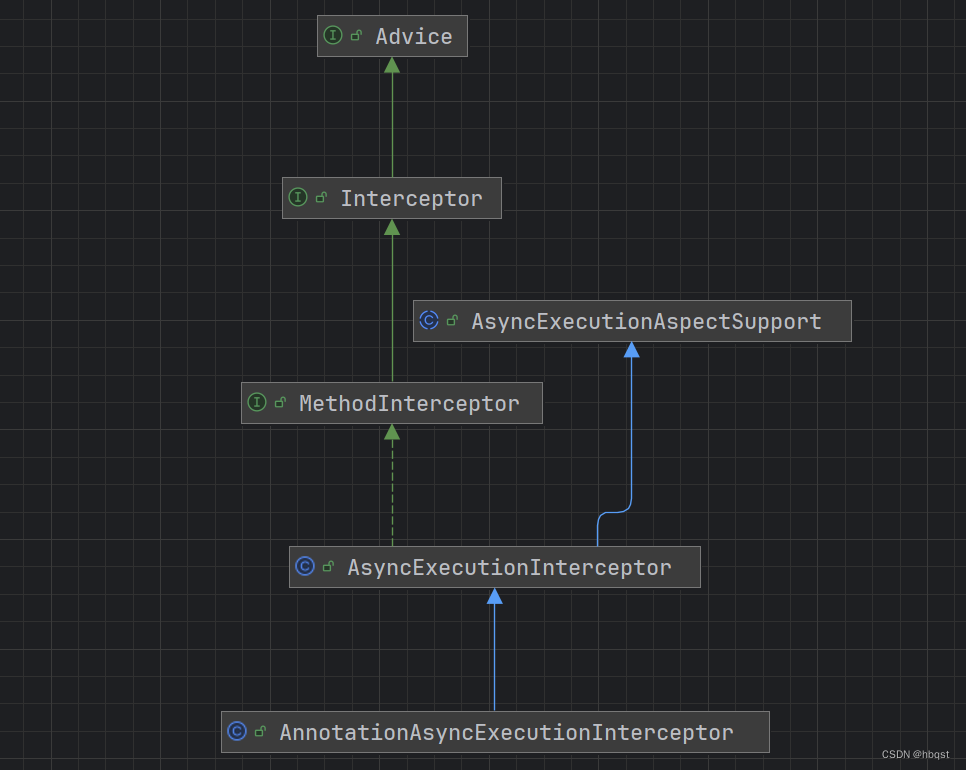通用配置
- 要想开启@Async支持,需要在配置类上加上@EnableAsync注解
- 这个配置类通常可以实现AsyncConfigurer,重写方法以自定义异步Executor和异常处理Handler
@Configuration
@EnableAsync
public class AsyncConfig implements AsyncConfigurer {
@Override
public Executor getAsyncExecutor() {
ThreadPoolTaskExecutor executor = new ThreadPoolTaskExecutor();
executor.setCorePoolSize(7);
executor.setMaxPoolSize(42);
executor.setQueueCapacity(11);
executor.setThreadNamePrefix("MyExecutor-");
executor.initialize();
return executor;
}
@Override
public AsyncUncaughtExceptionHandler getAsyncUncaughtExceptionHandler() {
return new SimpleAsyncUncaughtExceptionHandler();
}
}
@EnableAsync
- 导入AsyncConfigurationSelector
- annotation属性:可以自定义异步注解,默认支持@Async和@Asynchronous
- mode属性:默认使用动态代理,即运行时增强
@Target(ElementType.TYPE)
@Retention(RetentionPolicy.RUNTIME)
@Documented
@Import(AsyncConfigurationSelector.class)
public @interface EnableAsync {
Class<? extends Annotation> annotation() default Annotation.class;
boolean proxyTargetClass() default false;
AdviceMode mode() default AdviceMode.PROXY;
int order() default Ordered.LOWEST_PRECEDENCE;
}
AsyncConfigurationSelector
这是一个ImportSelector
AdviceModeImportSelector中重写了selectImports(AnnotationMetadata importingClassMetadata);同时定义抽象方法selectImports(AdviceMode adviceMode);
AsyncConfigurationSelector中实现抽象方法selectImports(AdviceMode adviceMode),这是一个典型的模板方法设计;

不管是那个selectImports,最终目的都是将返回值中的类对象注册到容器
这里即为ProxyAsyncConfiguration
public class AsyncConfigurationSelector extends AdviceModeImportSelector<EnableAsync> {
private static final String ASYNC_EXECUTION_ASPECT_CONFIGURATION_CLASS_NAME =
"org.springframework.scheduling.aspectj.AspectJAsyncConfiguration";
@Override
@Nullable
public String[] selectImports(AdviceMode adviceMode) {
switch (adviceMode) {
case PROXY:
return new String[] {ProxyAsyncConfiguration.class.getName()};
case ASPECTJ:
return new String[] {ASYNC_EXECUTION_ASPECT_CONFIGURATION_CLASS_NAME};
default:
return null;
}
}
}
ProxyAsyncConfiguration
这是一个配置类,注册了一个AsyncAnnotationBeanPostProcessor 的Bean;
在注册AsyncAnnotationBeanPostProcessor 之前,必须要确保enableAsync完成初始化(父类中进行);
然后配置AsyncAnnotationBeanPostProcessor 对象的一些属性,其中bpp.configure(this.executor, this.exceptionHandler);中的executor和exceptionHandler,也是在父类中赋值的
@Configuration(proxyBeanMethods = false)
@Role(BeanDefinition.ROLE_INFRASTRUCTURE)
public class ProxyAsyncConfiguration extends AbstractAsyncConfiguration {
@Bean(name = TaskManagementConfigUtils.ASYNC_ANNOTATION_PROCESSOR_BEAN_NAME)
@Role(BeanDefinition.ROLE_INFRASTRUCTURE)
public AsyncAnnotationBeanPostProcessor asyncAdvisor() {
Assert.notNull(this.enableAsync, "@EnableAsync annotation metadata was not injected");
AsyncAnnotationBeanPostProcessor bpp = new AsyncAnnotationBeanPostProcessor();
bpp.configure(this.executor, this.exceptionHandler);
Class<? extends Annotation> customAsyncAnnotation = this.enableAsync.getClass("annotation");
if (customAsyncAnnotation != AnnotationUtils.getDefaultValue(EnableAsync.class, "annotation")) {
bpp.setAsyncAnnotationType(customAsyncAnnotation);
}
bpp.setProxyTargetClass(this.enableAsync.getBoolean("proxyTargetClass"));
bpp.setOrder(this.enableAsync.<Integer>getNumber("order"));
return bpp;
}
}
这个类继承了AbstractAsyncConfiguration ,这个父类有两个作用
- 实现了ImportAware,意味着会在合适的时机自动调用setImportMetadata方法;这里即通过metadata获取@EnableAsync的注解信息,保存到enableAsync
- 导入自定义的AsyncConfigurer,设置executor和exceptionHandler,如果没有则返回null(这里先返回null,后面会有默认行为)
@Configuration(proxyBeanMethods = false)
public abstract class AbstractAsyncConfiguration implements ImportAware {
@Nullable
protected AnnotationAttributes enableAsync;
@Nullable
protected Supplier<Executor> executor;
@Nullable
protected Supplier<AsyncUncaughtExceptionHandler> exceptionHandler;
@Override
public void setImportMetadata(AnnotationMetadata importMetadata) {
this.enableAsync = AnnotationAttributes.fromMap(
importMetadata.getAnnotationAttributes(EnableAsync.class.getName()));
if (this.enableAsync == null) {
throw new IllegalArgumentException(
"@EnableAsync is not present on importing class " + importMetadata.getClassName());
}
}
/**
* Collect any {@link AsyncConfigurer} beans through autowiring.
*/
@Autowired
void setConfigurers(ObjectProvider<AsyncConfigurer> configurers) {
Supplier<AsyncConfigurer> configurer = SingletonSupplier.of(() -> {
List<AsyncConfigurer> candidates = configurers.stream().collect(Collectors.toList());
if (CollectionUtils.isEmpty(candidates)) {
return null;
}
if (candidates.size() > 1) {
throw new IllegalStateException("Only one AsyncConfigurer may exist");
}
return candidates.get(0);
});
this.executor = adapt(configurer, AsyncConfigurer::getAsyncExecutor);
this.exceptionHandler = adapt(configurer, AsyncConfigurer::getAsyncUncaughtExceptionHandler);
}
private <T> Supplier<T> adapt(Supplier<AsyncConfigurer> supplier, Function<AsyncConfigurer, T> provider) {
return () -> {
AsyncConfigurer configurer = supplier.get();
return (configurer != null ? provider.apply(configurer) : null);
};
}
}
AsyncAnnotationBeanPostProcessor
这是一个BeanPostProcessor,两个postProcess方法在AbstractAdvisingBeanPostProcessor中被实现;
另外注意到还实现了BeanFactoryAware,BeanFactoryAware的setBeanFactory回调方法是要在BeanPostProcessor的postProcess方法之前执行的,因此先关注setBeanFactory方法

AsyncAnnotationBeanPostProcessor重写了setBeanFactory方法
主要是创建了AsyncAnnotationAdvisor ,并赋值给advisor属性
@Override
public void setBeanFactory(BeanFactory beanFactory) {
super.setBeanFactory(beanFactory);
AsyncAnnotationAdvisor advisor = new AsyncAnnotationAdvisor(this.executor, this.exceptionHandler);
if (this.asyncAnnotationType != null) {
advisor.setAsyncAnnotationType(this.asyncAnnotationType);
}
advisor.setBeanFactory(beanFactory);
this.advisor = advisor;
}
AsyncAnnotationAdvisor 是一个Advisor(切面),其中定义了Advice(通知),Pointcut(切点)
public class AsyncAnnotationAdvisor extends AbstractPointcutAdvisor implements BeanFactoryAware {
private Advice advice;
private Pointcut pointcut;
// ...
}
回顾一下编码实现AOP ,需要几个核心对象
- MethodInterceptor
- ProxyFactory
- Pointcut
- Advisor(Pointcut + MethodInterceptor)
这里的AsyncAnnotationAdvisor 就是对应的第4个
参考
AsyncAnnotationAdvisor
看一下AsyncAnnotationAdvisor 的构造函数,是如何创建Pointcut和Advice的;
- 前面添加了@Async注解支持,以及尝试添加javax.ejb.Asynchronous
- 接着就是重点关注的,创建advice,pointcut
public AsyncAnnotationAdvisor(
@Nullable Supplier<Executor> executor, @Nullable Supplier<AsyncUncaughtExceptionHandler> exceptionHandler) {
Set<Class<? extends Annotation>> asyncAnnotationTypes = new LinkedHashSet<>(2);
asyncAnnotationTypes.add(Async.class);
try {
asyncAnnotationTypes.add((Class<? extends Annotation>)
ClassUtils.forName("javax.ejb.Asynchronous", AsyncAnnotationAdvisor.class.getClassLoader()));
}
catch (ClassNotFoundException ex) {
// If EJB 3.1 API not present, simply ignore.
}
this.advice = buildAdvice(executor, exceptionHandler);
this.pointcut = buildPointcut(asyncAnnotationTypes);
}
buildPointcut大概意思就是把默认的@Async注解和自定义注解都作为切点
buildAdvice中使用的是AnnotationAsyncExecutionInterceptor ,即增强方法(MethodInterceptor);
configure方法中就是没有自定义AsyncConfigurer时,默认的executor和exceptionHandler逻辑
protected Advice buildAdvice(
@Nullable Supplier<Executor> executor, @Nullable Supplier<AsyncUncaughtExceptionHandler> exceptionHandler) {
AnnotationAsyncExecutionInterceptor interceptor = new AnnotationAsyncExecutionInterceptor(null);
interceptor.configure(executor, exceptionHandler);
return interceptor;
}
public void configure(@Nullable Supplier<Executor> defaultExecutor,
@Nullable Supplier<AsyncUncaughtExceptionHandler> exceptionHandler) {
this.defaultExecutor = new SingletonSupplier<>(defaultExecutor, () -> getDefaultExecutor(this.beanFactory));
this.exceptionHandler = new SingletonSupplier<>(exceptionHandler, SimpleAsyncUncaughtExceptionHandler::new);
}
AnnotationAsyncExecutionInterceptor
增强方法invoke定义在AsyncExecutionInterceptor

到这逻辑就很清晰了,会将我们自己的方法包装成一个Callable,然后在doSubmit中执行;
执行过程中发生了异常,会找到exceptionHandler处理异常(如果我们自定义了的话);
doSubmit方法中,根据不同的返回值,执行相应的逻辑,从这里也可得知,可以将方法返回值定义为:
- CompletableFuture
- ListenableFuture
- Future
@Override
@Nullable
public Object invoke(final MethodInvocation invocation) throws Throwable {
Class<?> targetClass = (invocation.getThis() != null ? AopUtils.getTargetClass(invocation.getThis()) : null);
Method specificMethod = ClassUtils.getMostSpecificMethod(invocation.getMethod(), targetClass);
final Method userDeclaredMethod = BridgeMethodResolver.findBridgedMethod(specificMethod);
AsyncTaskExecutor executor = determineAsyncExecutor(userDeclaredMethod);
if (executor == null) {
throw new IllegalStateException(
"No executor specified and no default executor set on AsyncExecutionInterceptor either");
}
Callable<Object> task = () -> {
try {
Object result = invocation.proceed();
if (result instanceof Future) {
return ((Future<?>) result).get();
}
}
catch (ExecutionException ex) {
handleError(ex.getCause(), userDeclaredMethod, invocation.getArguments());
}
catch (Throwable ex) {
handleError(ex, userDeclaredMethod, invocation.getArguments());
}
return null;
};
return doSubmit(task, executor, invocation.getMethod().getReturnType());
}
@Nullable
protected Object doSubmit(Callable<Object> task, AsyncTaskExecutor executor, Class<?> returnType) {
if (CompletableFuture.class.isAssignableFrom(returnType)) {
return CompletableFuture.supplyAsync(() -> {
try {
return task.call();
}
catch (Throwable ex) {
throw new CompletionException(ex);
}
}, executor);
}
else if (ListenableFuture.class.isAssignableFrom(returnType)) {
return ((AsyncListenableTaskExecutor) executor).submitListenable(task);
}
else if (Future.class.isAssignableFrom(returnType)) {
return executor.submit(task);
}
else {
executor.submit(task);
return null;
}
}
创建代理对象
回到AsyncAnnotationBeanPostProcessor#postProcessAfterInitialization,在这里创建了最终的代理对象;
同时可以看到ProxyFacory对象,创建代理的基本步骤类似,可参考这篇文章
@Override
public Object postProcessAfterInitialization(Object bean, String beanName) {
if (this.advisor == null || bean instanceof AopInfrastructureBean) {
// Ignore AOP infrastructure such as scoped proxies.
return bean;
}
if (bean instanceof Advised) {
Advised advised = (Advised) bean;
if (!advised.isFrozen() && isEligible(AopUtils.getTargetClass(bean))) {
// Add our local Advisor to the existing proxy's Advisor chain...
if (this.beforeExistingAdvisors) {
advised.addAdvisor(0, this.advisor);
}
else {
advised.addAdvisor(this.advisor);
}
return bean;
}
}
if (isEligible(bean, beanName)) {
ProxyFactory proxyFactory = prepareProxyFactory(bean, beanName);
if (!proxyFactory.isProxyTargetClass()) {
evaluateProxyInterfaces(bean.getClass(), proxyFactory);
}
proxyFactory.addAdvisor(this.advisor);
customizeProxyFactory(proxyFactory);
// Use original ClassLoader if bean class not locally loaded in overriding class loader
ClassLoader classLoader = getProxyClassLoader();
if (classLoader instanceof SmartClassLoader && classLoader != bean.getClass().getClassLoader()) {
classLoader = ((SmartClassLoader) classLoader).getOriginalClassLoader();
}
return proxyFactory.getProxy(classLoader);
}
// No proxy needed.
return bean;
}





















 1897
1897

 被折叠的 条评论
为什么被折叠?
被折叠的 条评论
为什么被折叠?








